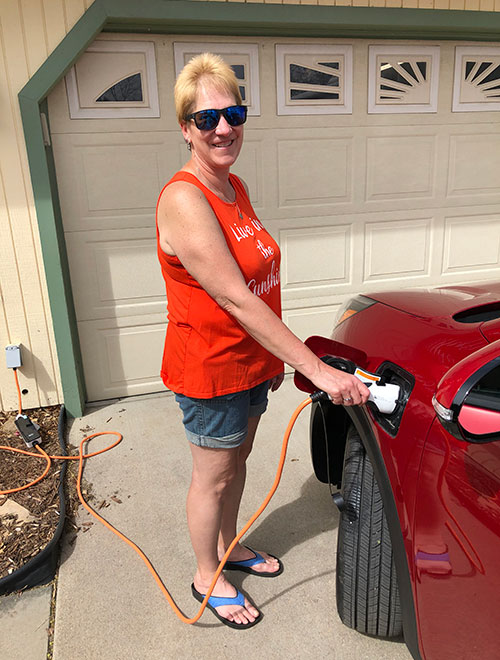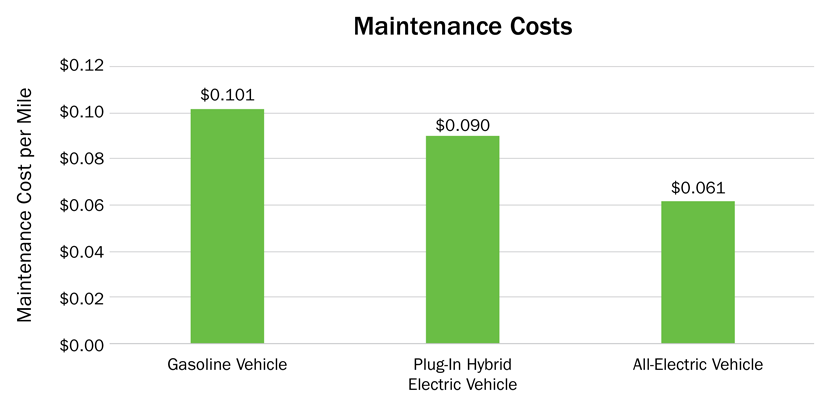Electric Vehicles for Consumers

For a summary handout, download the Electric Vehicles for Consumers fact sheet.
On This Page
More consumers are choosing electric vehicles (EVs) as new, competitively priced models with longer ranges hit the market. More public charging stations are also rapidly becoming available, and some offer quick charges to get drivers back on the road in minutes.
Your driving needs, charging options, and other considerations will help determine whether an EV is right for you.
Finding the Right Vehicle
New all-electric vehicles and plug-in hybrid electric vehicles are released all the time, with models designed to meet a wider variety of needs. To learn whether an EV is right for you, assess your driving requirements, vehicle availability, and prices and incentives.
Driving Requirements
To assess whether an EV meets your needs:
-
Start with daily driving: How many miles do you typically drive (e.g., for work, errands)? For daily driving, you'll likely charge at home or near work. Typically, most EV charging is done at home, but there is a growing network of chargers available for you to charge at workplaces, the grocery store, conventional gas stations, and many other destinations.
-
Next, consider longer trips: Are there public charging stations along your route that are compatible with the vehicles you're considering? Can you get from one station to the next within your expected range? The Chargeway app allows drivers to input a vehicle type and planned route and see what chargers are compatible with their vehicles along that route. Consumers should also ask the vehicle manufacturer about charger compatibility when making purchasing decision. Keep in mind, many EVs can easily travel distances of 200 to 300 miles on a single charge. Also consider whether your household has a second vehicle for longer trips, in which case you may be able to make do with an EV with shorter range.
-
Also factor in reduced range if your driving will include hilly terrain, hauling heavy loads, or a lot of heating or air conditioning use. In these cases, leave some extra buffer in the EV's maximum range.
If an all-electric vehicle doesn't meet your needs or you prefer the security of gasoline backup, consider a plug-in hybrid electric vehicle (PHEV). Keep in mind that a PHEV includes an internal combustion engine and associated maintenance requirements/costs—see Prices and Incentives. Compare the fuel economy and range of light-duty EVs and conventional vehicles at FuelEconomy.gov.
See Typical Consumer Stories for examples of how others meet their driving needs with EVs.
Vehicle Availability
EVs are becoming increasingly available in a variety of popular sizes and body styles, from compact hatchbacks to luxury SUVs and pickup trucks. See the AFDC Vehicle Search to find available models. Some models are available as gasoline or hybrid vehicles, as well as all-electric and PHEVs, making it easy to compare costs and benefits using the FuelEconomy.gov comparison tool. Also, see the following table for a comparison of different options for the Kia Niro.
Note that some EVs may only be available in certain states or dealerships, particularly when first released. Contact local dealerships or manufacturer websites to learn if a vehicle is available locally.
Unsure whether an EV is right for you in the long term? Many dealers offer lease options for a shorter-term commitment than outright purchase. This may be appealing because EVs include some special considerations:
-
Rapidly evolving technology: Most vehicle manufacturers are planning to release more EV models in the coming years, and a lease can be a great short-term solution that allows drivers to wait for their ideal model.
-
Incentives: Although the dealer or lessor receives any federal tax incentive for the vehicle, they may in turn pass these savings on to the customer. State or other local incentives may still be available to the lessee. Consult a qualified tax professional or the Internal Revenue Service before making any tax-related decisions.
-
Range anxiety: Many drivers are concerned about whether an EV can truly meet their driving needs (e.g., having sufficient range or access to public charging needed to make longer trips). A lease allows drivers to try an EV without the long-term commitment.
Prices and Incentives

Although the initial price of many EVs is higher than comparable gasoline counterparts, tax incentives and rebates can offset much of this price difference. Many all-electric vehicles and PHEVs qualify for a federal tax credit of up to $7,500, and state and local incentives may also be available (including up to $4,000 for pre-owned vehicles). Search the AFDC Laws and Incentives database or contact your Clean Cities and Communities coalition for the latest incentive information.
EV cost of ownership (your fuel and maintenance cost) is also lower (see chart), so you'll likely spend less over the life of the vehicle. This is especially true in the case of all-electric vehicles, which have much lower maintenance requirements. Use the AFDC Vehicle Cost Calculator to compare vehicle operating costs.
| Vehicle | Fuel Economy Rating* | All-Electric Range | MSRP | Annual Fuel Cost |
|---|---|---|---|---|
| 2023 Kia Niro Hybrid | 53 mpg | N/A | $26,590 | $1,100 |
| 2023 Kia Niro Plug-In Hybrid | 48/108 mpge** | 34 miles | $29,590 | $850 |
| 2023 Kia Niro Electric | 113 mpge | 253 miles | $39,550 | $650 |
| 2023 Chevrolet Bolt | 120 mpge | 259 miles | $26,500 | $650 |
| 2023 Ford Mustang Mach-E RWD | 103 mpge | 247 miles | $42,995 | $750 |
| Notes: For comparison purposes only. The 2023 Kia Niro is used based on its availability in hybrid, PHEV, and all-electric configurations to provide the most equal comparison. The three all-electric vehicles (in italics) allow for comparison among typical all-electric models. Values taken from FuelEconomy.gov and AFDC Vehicle Cost Calculator. *EVs are rated in miles per gallon of gasoline equivalent (mpge), the number of miles the vehicle can travel using a quantity of electricity with the same energy content as a gallon of gasoline. **For PHEVs, the lower value is for gasoline mode and the higher value is for gas/electric mode. |
||||
Charging Your Vehicle
All-electric vehicles must be charged regularly and charging PHEVs regularly will minimize the amount of gasoline they consume. Your EV will come with a Level 1 cordset for charging via a standard 120 volt (V) household outlet (e.g., in your garage or driveway), and your dealer or the vehicle manufacturer can recommend options for installing a Level 2 unit at home. A Level 1 unit can charge a smaller PHEV or partially depleted all-electric vehicle overnight, and Level 2 can generally charge a fully depleted all-electric vehicle overnight. Charging at night takes advantage of low, stable, residential electric rates. Learn more about charging at home. For people living in multifamily housing, charging is also becoming more increasingly available (see Electric Vehicle Charging for Multifamily Housing).
Charging at work can be as simple as plugging in to an available outlet (with permission from your employer) or using Level 2 charging equipment installed by the building owner.
Charging in public is another option. Tens of thousands of chargers are available nationwide, from 120 V outlets made available for using your cordset to DC fast charge (DCFC) units to quickly top off an all-electric vehicle in minutes (most PHEVs are not able to charge via DCFC). You can use the AFDC Station Locator to find public stations.
See EV Charging Options table.
| Location | Level 1 adds 2 to 5 miles/hour |
Level 2 adds 10 to 30 miles/hour |
DCFC adds 100 to 200+ miles in 30 minutes |
|---|---|---|---|
| Home | Portable cordset or hardwired unit Requires: 120 V outlet |
240 V portable or hardwired Requires: 240 V outlet or available service |
N/A |
| Work | Portable cordset or hardwired unit Requires: Available 120 V outlet |
240 V hardwired Requires: 208 V or 240 V available service |
N/A |
| Public | Some 120 V outlets are available and designated for public use | Available nationwide in areas where vehicles congregate (shopping centers, airports, public buildings, etc.) | Available in large population centers and along major highways |
Connectors
| Level | Connector |
|---|---|
| Level 1 |
|
| Level 2 |
|
| DC Fast |
|
Level 1 and Level 2 units use the same SAE J1772 connector to the vehicle, while public DCFC requires one of three possible connectors (Combined Charging System [CCS], CHAdeMO, or the North American Charging Standard [NACS]). Most EVs can charge at any public charging station, although Tesla vehicles use a Tesla-developed connector, called the NACS connector, and an adapter allows them to use non-Tesla equipment. Several vehicle manufacturers have announced adopting the NACS connector as early as 2025, which will allow non-Tesla EVs to charge at Tesla stations with the NACS connector. It's important to know which connector(s) are compatible with your vehicle of choice. Learn more about charging and connectors.
Installing EV Charging in Your Home
These key considerations about charging options, regulations, safety, and cost can help you get started planning for home charging.
-
Level 1 charging does not require special equipment, and most EVs come with a cordset
-
EV manufacturers should be able to recommend Level 2 charging equipment
-
Level 2 equipment cost varies, typically from $500 to $4,000 before installation and incentives
-
Options include smart products with enhanced displays, charging timers, communications capabilities, and keypads
-
Homes with adequate electrical service will incur lower installation costs, but upgrading electrical service can create additional expenses
-
Check with your utility and an electrical contractor to get cost estimates before installing charging equipment. Installers may need to submit an installation plan to a permitting authority.
-
Complying with regulations:
-
Charging equipment must comply with local, state, and national codes and regulations, and installation usually requires a licensed electrical contractor
-
Your building, fire, environmental, and electrical inspecting and permitting authorities may require permits
-
Your contractor should know the relevant codes and standards and check with the local planning department
-
-
Safety and maintenance considerations:
-
Safety risks are comparable to those from electric clothes dryers
-
Charging equipment is often installed in garages, but it can be installed outdoors and is safe to use in the rain
-
Charging cords are built to withstand heavy use even to the point of being driven over. Power doesn't flow unless the vehicle is plugged in and charging.
-
Your charging equipment should be certified by a nationally recognized testing laboratory such as UL Solutions, and ENERGY STAR® rated products are highly recommended
-
A wall unit should be protected from contact by the vehicle and positioned to avoid tripping hazards
-
-
Electricity costs for charging:
-
Fuel costs are lower than those for conventional vehicles; assuming an electricity cost of 12.3 cents/kWh, adding 100 miles of range to an EV battery will cost $2.46
-
An average all-electric vehicle traveling 15,000 miles in a year would use around 5,000 kWh, which can be compared to average energy used by central air between 1,000 and 4,500 kWh.
-
Charging in Public
It's also important to understand your options for public charging in your community, near your work, or for longer trips.
-
There are more than 190,000 charging ports in the United States, and the number is increasing rapidly.
-
Most stations are operated by a charging network provider, such as Blink or Electrify America, and each has its own model for collecting money for charging (e.g., per session, hourly, or by the amount of energy used). Although some locations offer free charging, drivers can normally expect to pay more when using public stations (especially DCFC stations) than for electricity costs incurred when charging at home.
-
Most public charging is Level 2 or DCFC and is located where vehicles are highly concentrated (e.g., shopping centers, parking lots, garages, airports, hotels, government offices), as well as along highway corridors.
Driving and Maintaining Your EV
EVs are as easy to drive and maintain as conventional vehicles, but some special considerations apply:
-
Planning Ahead: It is essential to plan ahead before a longer trip or when your all-electric vehicle's battery is low. While gas stations can be found most anywhere in the United States, charging stations are not yet as common. So, it's best to ensure that your battery is fully charged before leaving on a long trip and plan out charging stops along the route as needed. Note that the AFDC Station Locator includes a phone number for each station, enabling drivers to call ahead to ensure the station is operational and available. There are also free station mapping apps and preinstalled software in some EVs that can help with planning.
-
Battery Life: EV batteries are generally designed to last for the expected lifetime of the vehicle but will wear out eventually. Manufacturers typically offer 8-year/100,000-mile warranties, and these may be even longer in some states. Check with your EV dealer about battery lifetime and warranties. At the end of their useful life in EVs, batteries can be recycled and reused for secondary applications. Once an EV battery pack is removed from a vehicle, the used batteries can be taken to a refurbishing facility for testing and reconfiguration for use in stationary applications, like back-up power for telecommunication systems during power outages.
-
Safety: The first thing you'll notice when driving an EV is how quiet it is. Most produce an audible sound at low speeds or while in reverse, but drivers should use extra caution in pedestrian areas. EVs tend to have a lower center of gravity, making them less likely to roll over and generally improving ride quality. Although battery fires are often expressed as a safety concern, EV fires are actually significantly less frequent than fires involving gasoline-powered vehicles.
-
Maintenance: Because all-electric vehicles' electrical systems require little maintenance, drivers can expect reduced maintenance requirements and associated cost. PHEVs have internal combustion engines, so their maintenance requirements are comparable to those of conventional vehicles. Learn more about EV maintenance.
Typical Consumer Stories
- Meet Judy: Judy owns an all-electric vehicle and drives 20 miles round trip for work each day. She charges the car at home overnight using her cordset and an outlet in her garage. Once Judy decides that she's ready for a longer commitment, she plans to have a Level 2 charger installed. Judy makes occasional trips out of state to see family and uses a DCFC station along the route.
- Meet Paola: Paola drives less than 20 miles round trip for work each day. She charges her PHEV at home using Level 1 and uses a public Level 2 station down the street occasionally. Paola opted to lease a PHEV to accommodate trips out of state but plans to switch to all-electric when her lease expires.
- Meet Erik and Deb: For their daily commute, an all-electric hatchback meets this couple's needs. They have a light-duty pickup to pull their trailer when on vacation, for hauling loads or camping, or when they each need a vehicle.
Find more consumer testimonials at Plug In America.



